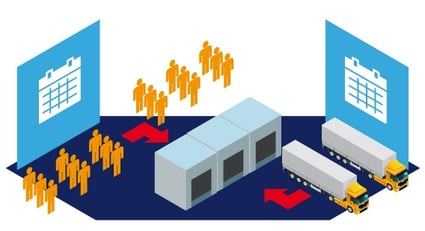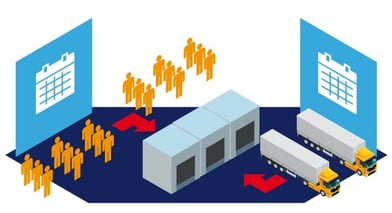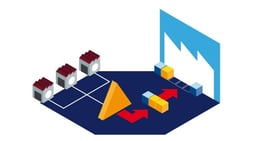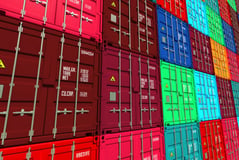How Supply Chain Integration Impacts S&OP
Brian Hoey - March 31, 2020

 Let's say you’re a chef at a fancy farm-to-table restaurant. You don’t have a set daily menu for your dinner service, focusing instead whatever fresh produce and other ingredients you can lay your hands on. This gives you a lot of room for creativity, but it also puts a lot of pressure on your supplier relationships. While the chain restaurant down the block places the same order (with small adjustments) through the same produce supplier every week, you need to consider seasonality, brainstorm potential dishes, and have a frank discussion with your supplier about which items in a given week are going to best meet the needs of your culinary mission.
Let's say you’re a chef at a fancy farm-to-table restaurant. You don’t have a set daily menu for your dinner service, focusing instead whatever fresh produce and other ingredients you can lay your hands on. This gives you a lot of room for creativity, but it also puts a lot of pressure on your supplier relationships. While the chain restaurant down the block places the same order (with small adjustments) through the same produce supplier every week, you need to consider seasonality, brainstorm potential dishes, and have a frank discussion with your supplier about which items in a given week are going to best meet the needs of your culinary mission.
And, of course, it’s not just about trusting your supplier. Your supplier needs to have a strong rapport with the farmers she sources from, so that she can give an accurate snapshot of the supply situation. If communication breaks down along this chain, the results for your restaurant could be problematic—anything from ingredient stockouts to sub-standard dishes.
While this anecdote might not seem like it has much to do with industrial supply chain management, it’s a powerful elucidation of the importance of supply chain integration. You might not be using seasonal produce at your factory, but you certainly are relying on your suppliers to give you the most up-to-date possible information on the raw materials you’re sourcing. As it happens, one of the areas where this can be most impactful is one that planners are increasingly relying on for smooth supply chain operations: sales and operations planning (S&OP).
Why Does Supply Chain Integration Matter?
Above, we hinted at the ways that supply chain integration can improve visibility downstream in the value chain, offering valuable insights for procurement and production planning processes. But let’s dig a little deeper into why exactly that’s the case. Let’s say you have a demand forecast that projects likely order volumes for your top selling products for the next quarter—what additional information do you need in order to operationalize that forecast into a fully-fledged plan? For starters, you might want to know:
- If the prices of your raw materials have fluctuated at all since your last planning round
- Whether lead times and transport costs for your order are likely to increase or decrease
- Whether there have been any recent supplier-side stockouts or other disruptions
- How much demand there currently is for the parts and materials you need in your production processes.
With this information in tow, you can ostensibly get proactive about how you’re sourcing what you need to fulfill orders, and you can see potential disruptions in advance and build in the flexibility and agility your production flows need in order to withstand those disruptions. In this way, you manage costs and keep your longer term plans on track. The only problem? You need a reliable way of getting this information from your suppliers. Sure, you could just call them on the phone—but if you want updated information in real-time, you really need some kind of IT integration that connects their data streams to yours. This, in a nutshell, is why supply chain integration matters for S&OP planners.
Challenges in Supply Chain Integration
Now, at this point you might be thinking, “If integration is so important, why isn’t it standard across the supply chain?” It’s a reasonable question, and it highlights the fact that supply chain integration, though critical to successful planning in the Industry 4.0 era, can present challenges. For starters, IT integrations up or downstream in the supply chain require that your existing IT infrastructure be able to support new data sources in a flexible way. As such, the current levels of visibility and transparency within your own operation will play an important role in making integration feasible. Ask yourself:
- Are there any data silos across various touchpoints within your operation?
- Where are existing plans and datasets being stored? How accessible are they to planners?
- What happens if someone needs to rearrange production ratios on the fly? How and where do they do so, and how do the new plans make their way to other touchpoints?
- Is there any Shadow IT within your operation, i.e. software that’s being used without the sanction of the IT department or leadership?
If your internal audit of these factors reveals that information is easy to access and easy to incorporate into planning flows, integration is merely the next step in powering up visibility. If, on the other hand, your answers to these questions reveal relatively poor visibility, you’ll need to address those issues before you can expect successful partner integration.
Choosing the Right S&OP Software
At this point it bears mentioning that S&OP is a process that’s fundamentally technology-driven. As such, the success or failure of many of the things we’ve discussed above (both in terms of boosting internal visibility and gaining visibility up and downstream to improve planning workflows) will depend on the quality of software you’re using to power your S&OP. So, what should you look for in the right piece of sales and operations planning software? For starters, you should consider how it collects, stores, and makes available operational data: Does it connect easily to multiple data sources? Can it offer real-time updates as plans and caches of data receive changes and updates? Does it offer real-time analyses of proposed plans? Are its statistical forecasting capabilities robust?
If your S&OP software provider can give a strong ‘yes’ to those questions, you’re likely to be well-positioned for successful supply chain integration down the road. If not, that should be a red flag. After all, once you’ve got the right software in place to power increased integration, you can begin to increase agility and decrease disruptions at every touchpoint on the value chain. With data integrated from your supply chain partners, you can improve your forecasts in order to power more realistic quarterly and yearly plans. With those plans in place, you can leverage software integration to see disruptions coming in advance and use all of the resources at your disposal to fend them off. In this way, you can begin to improve margins and bolster your overall supply chain performance.
LATEST POSTS
- Understand Circular Economy in The Manufacturing Industry
- How Can Industry 4.0 IT Integration Be Achieved Smoothly?
- The Significance of Order Sequencing in Discrete Manufacturing
- How to improve your Supply Chain Management: The Power of Control Towers
- Optimizing Human Resource Scheduling in Manufacturing: A Technological Approach



